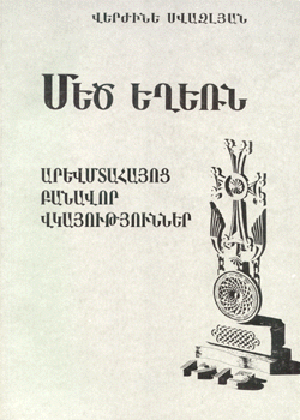
| About this page in Armenian |

Recently, the interest around the Armenian nation's fatal Genocide increased, as far as the Turkish historiography obstinate to distort the reliable historical events. In a sense, except of the official published documents, the folk songs and memoirs, created directly under the impression of the events mentioned above, have an exceptional historico-factual importance and were not inscribed and researched in Armenia until now.
After the Genocide of the Armenians in 1915, the deportation from Cilicia (1921) and the disaster of Ismir (1922), considerable part of the Western Armenians was exterminated. The rest, which escaped and survived by miracle, remained homeless and unmotherland. So they were obliged to settle in different countries of the world, creating the Armenian Diaspora as a historical phenomenon.
After long wanderings, most of them repatriated to Soviet Armenia and settled in new localities which symbolized their past cradle.
This collection includes memoirs and folk songs of historical character (in Armenian and in Turkish languages), which, since 1950s, we have inscribed in Armenia and partly in the Diaspora, created by the Armenians deported from Western Armenia, Cilicia and the localities of Anatolia, who reproduced the eldest generation of eye-witness repatriates, salved by miracle from the Genocide.
These factual documents really reflect the military muster, the mass exile, massacre and slaughter organized by the Turks, also the heroic self-defense and the overwhelms of Van, Sasoun, Moush, Shatakh, Shapin-Garahisar, Zeytoun, Moussa Dagh, Ourfa and other places, later in 1920-1921 Marash, Ayntap, Hadjn.
In spite the movements were crushed by the Turkish autocracy, the fearless heroes, who struggled for their elementary rights and physical resistance of their nation, left a bright sign in the history of the national liberation struggle.
In the process of noting the materials we tried to be faithful to the oral speech of 230 narrators, to the specific dialogue of their languages. Some interpretations are given by special footnotes.
Besides the folk materials, the collection includes a scientific introduction, where parallel to the historical events we researched the inscribed folk materials, the original texts and notes of which are kept in the fund of the folklore archive Verjine Svazlian at the Institute of Archaeology and Ethnography of Armenia's National Academy of Sciences.
The collection has a vocabulary of foreign words and dialects, footnotes, a map, songs accompanied by musical notes, historical photos, information about the narrators and their photographs.
In the course of tens of years period word by word, fragment by fragment the inscribed and presented oral materials, because of their original and valuable historical cognition remain reliable, factological and documental evidences, reflecting by a simple folk language the events of the Armenian Genocide.

|
Previous Cilicia | Next Turkish Language Songs |